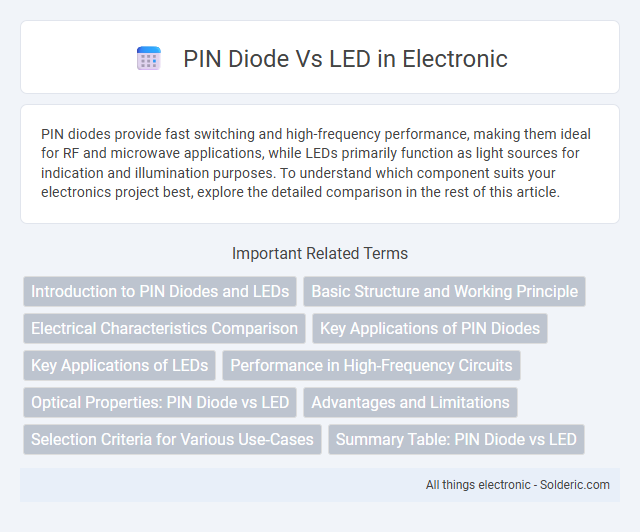PIN diodes provide fast switching and high-frequency performance, making them ideal for RF and microwave applications, while LEDs primarily function as light sources for indication and illumination purposes. To understand which component suits your electronics project best, explore the detailed comparison in the rest of this article.
Comparison Table
| Feature | PIN Diode | LED (Light Emitting Diode) |
|---|---|---|
| Function | Switching, RF signal modulation, photodetection | Light emission, indication, illumination |
| Structure | Layered P-type, Intrinsic, and N-type semiconductor | PN junction diode with semiconductor active layer |
| Operation Principle | Modulates RF signals by varying resistance | Emits photons when forward biased |
| Applications | RF switches, attenuators, photodetectors | Indicators, displays, optical communications |
| Response Time | Fast switching speed | Moderate, suitable for visible light emission |
| Light Emission | No | Yes |
| Biasing | Forward and reverse bias for switching | Forward bias for light emission |
| Material | Silicon-based | Gallium arsenide (GaAs), gallium phosphide (GaP), others |
Introduction to PIN Diodes and LEDs
PIN diodes, composed of an intrinsic semiconductor layer between p-type and n-type regions, are primarily used as high-speed switches and photodetectors due to their fast response and ability to handle high-frequency signals. LEDs (Light Emitting Diodes) are semiconductor devices that convert electrical energy into light through electroluminescence, widely used for indicator lights and displays. While PIN diodes optimize electrical switching and photonic detection, LEDs focus on efficient light emission for visual applications.
Basic Structure and Working Principle
A PIN diode consists of an intrinsic semiconductor layer sandwiched between p-type and n-type regions, enabling it to act as a variable resistor at high frequencies by controlling carrier injection. An LED (Light Emitting Diode) is made from a p-n junction semiconductor that emits light when forward biased, due to electron-hole recombination in the active region. While the PIN diode is primarily used for switching and RF applications, the LED functions as an optoelectronic device converting electrical energy into visible light.
Electrical Characteristics Comparison
PIN diodes exhibit high-speed switching and low capacitance, making them ideal for RF and microwave applications, while LEDs primarily function as light emitters with forward voltage ranges typically between 1.8V and 3.3V depending on the color. The PIN diode's intrinsic layer results in high resistance and low leakage current under reverse bias, contrasting with the LED's significant forward current designed to produce light emission. Your choice between a PIN diode and LED should consider these distinct electrical properties to match the device's role in signal modulation versus illumination.
Key Applications of PIN Diodes
PIN diodes are widely used in RF switches, attenuators, and photodetectors due to their ability to handle high-frequency signals and fast switching capabilities. Their intrinsic layer allows for efficient carrier storage, making them ideal for microwave circuits and optical communication systems. Unlike LEDs, which primarily serve as light emitters, PIN diodes excel in applications requiring signal modulation and detection.
Key Applications of LEDs
LEDs are widely used in display technology, indicator lights, and general illumination due to their high efficiency and long lifespan. Their ability to emit light in various colors makes them ideal for visual signaling and decorative purposes. You can find LEDs in automotive lighting, digital screens, and smart home devices, where reliable and energy-saving light sources are essential.
Performance in High-Frequency Circuits
PIN diodes excel in high-frequency circuits due to their intrinsic layer, which provides fast switching and low capacitance, enabling efficient signal modulation and attenuation. LEDs, primarily designed for light emission, exhibit slower response times and higher junction capacitance, limiting their effectiveness in high-frequency applications. Your circuit's high-frequency performance and signal integrity are better supported by the rapid switching capabilities of PIN diodes.
Optical Properties: PIN Diode vs LED
PIN diodes exhibit faster response times and higher sensitivity to light due to their intrinsic layer, making them ideal for high-speed optical detection. LEDs emit light through electroluminescence with specific wavelength ranges, providing efficient illumination and signaling capabilities. Your choice depends on whether you need precise light detection (PIN diode) or reliable light emission (LED) for your application.
Advantages and Limitations
PIN diodes offer high-speed switching and low noise performance, making them ideal for RF and microwave applications, while LEDs excel in efficient light emission and wide visibility for display and indicator uses. PIN diodes have limitations in low light output and require biasing, whereas LEDs are limited by slower response times and heat dissipation at high currents. Your choice depends on whether you prioritize fast electronic switching or effective illumination.
Selection Criteria for Various Use-Cases
PIN diodes excel in high-frequency switching and RF applications due to their fast response time and low capacitance, making them ideal for signal modulation and attenuators. LEDs are preferred in display and indicator applications where visible light emission is necessary, with selection criteria emphasizing brightness, color, and energy efficiency. Your choice depends on whether you need electrical signal control with minimal latency or functional illumination and signaling.
Summary Table: PIN Diode vs LED
PIN diodes exhibit fast switching speeds, low capacitance, and are primarily used in RF switching, photodetection, and high-frequency applications, while LEDs function as light sources emitting visible or infrared light in displays and indicators. The PIN diode's intrinsic layer between the p and n regions allows for efficient photodetection and signal modulation, whereas LEDs rely on electroluminescence in a semiconductor junction to produce light. Key differences include the PIN diode's electrical signal modulation capabilities versus the LED's optical emission, with varying forward voltages (typically 0.7 V for PIN diodes and 1.8-3.3 V for LEDs) and response times suited to their respective roles in electronics.
PIN diode vs LED Infographic

 solderic.com
solderic.com